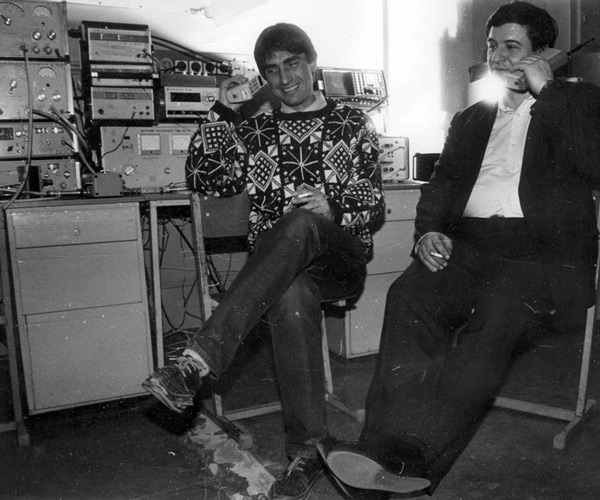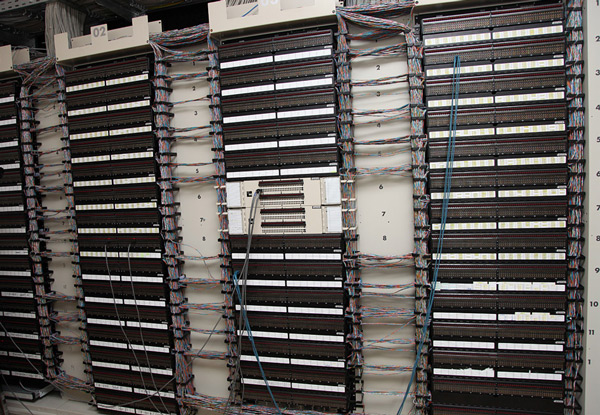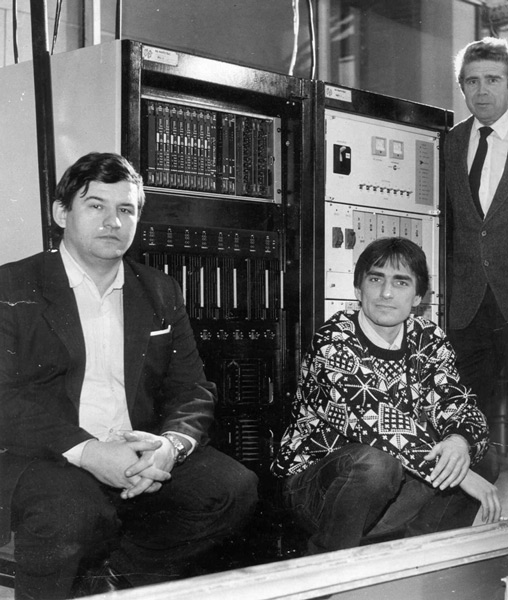First base station and first call
Congratulations to all employees of the telecom sector and IT-sphere with the sysadmin day! This month we had another professional holiday - it turned 20 years since the first call on the VimpelCom network.
The story is remarkable because 20 years ago we had to do reverse-engineering of the American module, in which the Americans themselves did not believe. Below in the topic is a pair of photographs of the equipment of those years and memories of a participant in the events in 1992.

Suvorov G.M. and Nikolaev I.N. at the first stand to adjust. Subsequently, it was replaced by one small device company "Marconi Instruments". In the hands of the first Motorola.
')
The BS equipment consisted of two cabinets - a PLEXSYS radio cabinet and a power supply cabinet with a battery. The radio cabinet consisted of 8 purely analog channels, that is, respectively, it could simultaneously service 8 subscribers. The cabinet was connected to the MSC switch with one PCM stream.
Each channel consisted of a radio interface board, a transceiver, and a power amplifier. At the output of each amplifier there was a resonator, which all together formed a filter-adder, and when changing the frequency plan - each resonator was tuned manually. In addition, there were enough of various other regulators, which were set up manually on the instruments. The use of such exotic at the time things like a laptop when setting up was not provided.
The radio cabinet was connected to three OMNI antennas - two receiving and one transmitting. Since all the equipment was located quite high - on the 32nd floor - a sufficiently acceptable coverage area was provided.

PLEXSYS Transceiver

Transceiver and resonator filter-adder

Dmitry Borisovich Zimin. Founder and Honorary President of VimpelCom
Then it all worked. After the launch of the first BS, licenses were obtained and the first VimpelCom network was organized for 200 subscribers. By the standards of those years, this is a lot: after all, a cell phone cost as a good car, and was issued against a receipt obliging to return it at the first request of the company.

BS equipment

Fixed equipment. Also installed in the building of the Ministry of Foreign Affairs.

From left to right: Nikolaev I.N., Suvorov G.M., Vaisman Yu.I. at the second base station PLEXSYS (completely identical to the first), on the right is a power supply cabinet manufactured by Vimpelcom
The history of the development of the first cellular networks and other technical and organizational details are well described in D. Zimin’s book “From 2 to 72. A picture book”, from which, in fact, the quotes above are given. There are a lot of facts with the taste of Russian specifics, for example, another wonderful extract from another part:
The story is remarkable because 20 years ago we had to do reverse-engineering of the American module, in which the Americans themselves did not believe. Below in the topic is a pair of photographs of the equipment of those years and memories of a participant in the events in 1992.

Suvorov G.M. and Nikolaev I.N. at the first stand to adjust. Subsequently, it was replaced by one small device company "Marconi Instruments". In the hands of the first Motorola.
')
What did the first base station look like?
The BS equipment consisted of two cabinets - a PLEXSYS radio cabinet and a power supply cabinet with a battery. The radio cabinet consisted of 8 purely analog channels, that is, respectively, it could simultaneously service 8 subscribers. The cabinet was connected to the MSC switch with one PCM stream.
Each channel consisted of a radio interface board, a transceiver, and a power amplifier. At the output of each amplifier there was a resonator, which all together formed a filter-adder, and when changing the frequency plan - each resonator was tuned manually. In addition, there were enough of various other regulators, which were set up manually on the instruments. The use of such exotic at the time things like a laptop when setting up was not provided.
The radio cabinet was connected to three OMNI antennas - two receiving and one transmitting. Since all the equipment was located quite high - on the 32nd floor - a sufficiently acceptable coverage area was provided.

PLEXSYS Transceiver

Transceiver and resonator filter-adder
Valery Trepakov (event participant) about the first call
... As mentioned earlier, the first base station of the Euronet cellular network (now Beeline) was installed in the building of the Ministry of Foreign Affairs (MOFA in American terminology). The switchboard of the Plexsys mobile base station system was connected to the switch 244 of the MTS PBX (for calls within the USSR) and to the international PBX type S12 of the Combelga company. For about two weeks after the installation of the station, we could not solve the problem of the digital switchability of a cellular system with urban exchanges, which at the time were, at best, coordinate-step or "quasi-digital" (there was such a term!). I remember when, at the end of 1991, American specialists from Cellular Inc. visited a number of our PBXs, they fell into a state of shock: “How can this work? ..”. The main problem was that the time characteristics (the duration of the call and dialing pulses) of our PBXs at that time did not meet international standards. Aleksanr Bashmakov, head of the Ministry of Foreign Affairs PBX, at the end of June 1992 transferred all the information on the Miussky telephone center alarm system to which 244 ATS Ministry of Foreign Affairs was connected to Plexsys chief engineer Jim Davies (this talented engineer subsequently left Plexsys with the entire engineering team and founded CellCore ) and Volodya Volynsky (in my opinion, one of the best hackers of that time), an employee of the Zimin department in RTI.
Two weeks later, the American team again arrived in Moscow, and Volodya Volynsky, “splits” the American program of communication of the mobile switch with the “outside world”, wrote down the necessary, in his opinion, program in the “memory chip” (I use the terminology of modern computer scientists) and wrapped up this microchip in foil like candy.
Launch
Volodya Volynsky approaches Jim and, stretching his “candy”, says:
“Try this, maybe IT will help?”
Jim (asks me): "Who is this and what does he want to give me?"
I answer: “This is the best programmer for RTI, and he“ split ”your program for the switch. Here is his solution to our problem. ”
Jim: “I respect Russian specialists, but don't count me as an asshole” (sorry, this is a very mild translation of what a southerner from the USA said). After turning the candy in his hands, Jim sat down at the computer, putting it, however, on the table beside him and saying, “Let all of them fuck away. All of them. Keep your mobile on. I will call you ... "We all left the machine room, not quite clearly following the" fuck away "command. Many wanted to stay. In the corridor of the PBX, where in the corner on a short couch, Jim's wife got numbed, despite the ban, we smoked, almost without stopping, while Jim “conjured” at the computer for about an hour and a half. Dmitry Borisovich Zimin every five minutes asked where to take a sip of coffee, but then he waved his hand and, saying, “fuck it, with this coffee”, shaking hands with excitement, lit a new cigarette from an almost half-decayed old one. ”
The first call (says D. Zimin)
“... Approximately 14.00.
... Suddenly, the cell phone that I held in my hand rang, for it was the Motorola-Classic, which in the US was called a “brick”, and it was impossible to shove it into a jacket pocket (by the way, it is terribly reliable - they can hammer nails). Pressing "send" and hearing the voice of Jim Davis, asked how things were going ... He replied that he was not calling from a cell phone, but from a city phone that was standing next to a computer. “And what, can I also call someone in the city?” I asked. “Try it,” Jim replied. I dialed my mom's phone number ...

Dmitry Borisovich Zimin. Founder and Honorary President of VimpelCom
What's next?
Then it all worked. After the launch of the first BS, licenses were obtained and the first VimpelCom network was organized for 200 subscribers. By the standards of those years, this is a lot: after all, a cell phone cost as a good car, and was issued against a receipt obliging to return it at the first request of the company.

BS equipment

Fixed equipment. Also installed in the building of the Ministry of Foreign Affairs.

From left to right: Nikolaev I.N., Suvorov G.M., Vaisman Yu.I. at the second base station PLEXSYS (completely identical to the first), on the right is a power supply cabinet manufactured by Vimpelcom
More details
The history of the development of the first cellular networks and other technical and organizational details are well described in D. Zimin’s book “From 2 to 72. A picture book”, from which, in fact, the quotes above are given. There are a lot of facts with the taste of Russian specifics, for example, another wonderful extract from another part:
... And on August 16, 1994 a base station was stolen from us. A base station is a locker packed with radio equipment. One does not raise. Stolen along with batteries and antenna. At night.
Source: https://habr.com/ru/post/148590/
All Articles